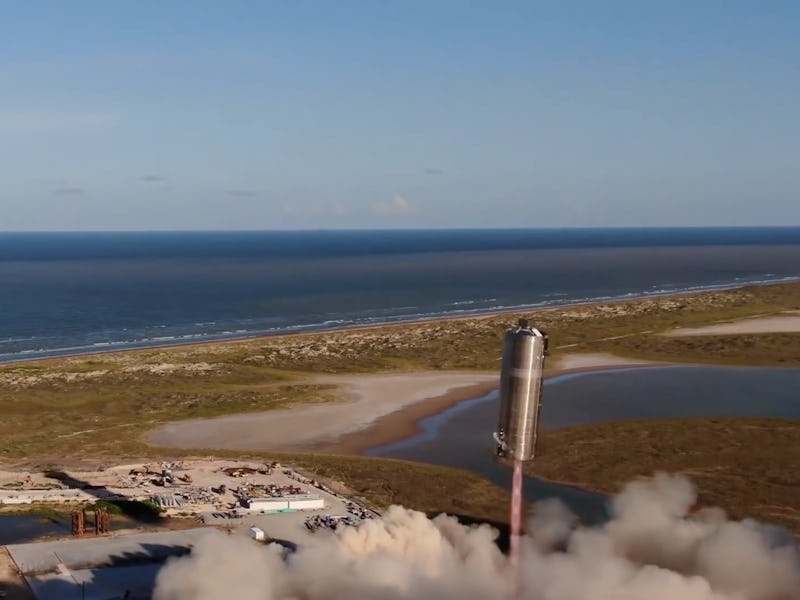SpaceX Starship: incredible video shows prototype soaring in first flight
The SpaceX Starship is designed to send humans to Mars and beyond, and it's now taken a step closer to full flight.

SpaceX has done it. On Tuesday, the company sent one of its Starship prototype vehicles nearly 500 feet into the air, a key step toward its goal of getting the stainless steel behemoth ready for spaceflight.
"Mars is looking real," SpaceX CEO Elon Musk wrote on his Twitter page after the launch.
The prototype's successful launch is another step in perhaps SpaceX's most ambitious project. The Starship was unveiled under the name "BFR" in September 2017, a fully-reusable rocket that flies using liquid oxygen and methane. Astronauts can fly to Mars, refuel, and either come home or continue out further. The ship is also designed for smaller missions like satellite launches, currently undertaken by the semi-reusable Falcon 9.
SpaceX completed a hop test to the same altitude in August 2019, with a tiny "Starhopper" ship that Musk compared to "R2D2's dad." That ship had the same nine-meter (30 feet) diameter as the final ship, but measured 18 meters (60 feet) tall. The following month, Musk unveiled the first full-size "Mk.1" prototype with the same diameter but a 50 meter (164 feet) height. The final ship is expected to pair with the Super Heavy booster to leave Earth, giving it a total height of nearly 122 meters (400 feet).
The prototype that flew on Tuesday was dubbed "SN5." On July 30, the prototype completed a static test fire that fired the engine without moving the vehicle. SpaceX skipped a hop test on Monday due to one of the engine's valves not opening.
The final version is expected to sport several more features, including a nosecone that will help the ship to carry 100 people or 150 tons into space. The final version is also expected to sport six Raptor engines on the ship itself, plus up to 37 engines on the Super Heavy booster. This "SN5" prototype was initially expected to feature a nosecone, as well as three Raptor engines in a triangle configuration. The prototype that flew was missing the nosecone, and only featured one "SN27" Raptor. NASASpaceflight noted that the Raptor's asymmetrical placement caused the ship to "powerslide" at launch.
Eagle-eyed photographers even captured the ship extending its legs to land:
After the flight, Musk explained that the version 1.1 legs will be 60 percent longer. The version 2.0 legs will be wider and taller. These legs will be more akin to the Falcon 9, but they will be capable of landing on unimproved surfaces and auto-leveling.
From here, Musk explained the company plans to host several small hops before moving onto more ambitious high altitude flights using body flaps.
SpaceX has big plans for the final Starship. The ship is expected to host a satellite launch with a commercial partner as its first mission. Musk has also set the ambitious goal of sending cargo Starships to Mars in 2022, paving the way for a crewed mission to Mars as early as 2024.
The Inverse analysis – The Starship's successful hop test is an important step forward in a project that seems almost unreal. SpaceX has been working away at its Boca Chica facility in Texas to build these giant stainless steel prototype ships, and after today it can say that it's successfully made one of them fly.
When the "Starhopper" flew in August 2019, its short design made it look rather sweet. When "SN5" flew, its large steel exterior made it seem like a silo soaring into the air. The first flight of the complete Starship, aided by Super Heavy, could bring an ever-more dramatic sight as the gargantuan ship sets its sights on Mars.
The Starship’s journey, summarized
- November 2018 – BFR, first announced in September 2017, gets renamed to Starship.
- December 2018 – Musk confirms the new ship has switched to stainless steel.
- January 2019 – Shortened “Starhopper” prototype unveiled and Musk explains the switch to steel.
- February 2019 – Raptor engine beats a long-standing rocket record.
- April 2019 – Starhopper completes a tethered “hop.”
- July 2019 – Starhopper launches 20 meters (67 feet).
- August 2019 – Starhopper launches 150 meters (500 feet).
- September 2019 – Starship Mk.1 full-size prototype unveiled.
- May 2020 – Starship SN4 full-size prototype completes a static test fire.
- August 2020 – Starship SN5 launches 150 meters (500 feet).
This article was originally published on